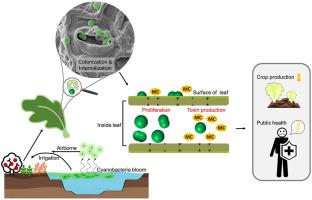Food Microbiology ( IF 4.5 ) Pub Date : 2020-10-06 , DOI: 10.1016/j.fm.2020.103655 Seungjun Lee 1 , Jinnam Kim 2 , Jiyoung Lee 3

|
Cyanobacteria are a threat to the safety of water sources for drinking, recreation, and food production, because some cyanobacteria, such as Microcystis, produce cyanotoxins. However, the colonization of plants by Microcystis and the fate of their toxin, microcystins (MCs), in agricultural environments have not been thoroughly studied. This study examined the colonization of lettuce, as a representative of leafy greens, by Microcystis and its potential impact on food safety and crop health. The surfaces of lettuce leaves were exposed to environmentally relevant concentrations of M. aeruginosa (104, 106, and 108 mcyE gene copies/mL) by mimicking contamination scenarios during cultivation, such as spraying irrigation with contaminated water or deposits of airborne Microcystis. Scanning electron microscope (SEM) and droplet digital PCR were used. The results showed that M. aeruginosa colonized the surface of leaves and MCs accumulated in the edible part of the lettuce (>20 μg/kg of lettuce). Crop productivity (length, weight, and number of leaves) was negatively affected. The SEM images provide evidence that M. aeruginosa deposited on the lettuce surface can be internalized via natural opening sites of the leaves and then proliferate within the plants. Our findings imply that toxic cyanobacteria contamination in agricultural environments can be a significant cyanotoxin exposure pathway.
中文翻译:

有毒蓝藻在绿叶植物表面和内部的定殖:蓝藻毒素产生和暴露的隐藏来源
蓝藻对饮用水、娱乐和食品生产的水源安全构成威胁,因为一些蓝藻,如微囊藻,会产生蓝藻毒素。然而,微囊藻在植物上的定殖及其毒素微囊藻毒素 (MC) 在农业环境中的命运尚未得到彻底研究。这项研究考察了微囊藻在绿叶蔬菜代表生菜上的定殖及其对食品安全和作物健康的潜在影响。通过模拟培养过程中的污染场景,例如用受污染的水或空气中的微囊藻沉积物喷洒灌溉,将生菜叶子的表面暴露于环境相关浓度的铜绿微囊藻(10 4 、10 6和 10 8 mcyE基因拷贝/mL)中。使用扫描电子显微镜(SEM)和液滴数字PCR。结果表明,铜绿微囊菌在叶片表面定殖,MCs在生菜可食部分积累(>20 μg/kg生菜)。作物生产力(长度、重量和叶子数量)受到负面影响。扫描电镜图像提供的证据表明,沉积在生菜表面的铜绿假单胞菌可以通过叶子的自然开口位点内化,然后在植物内增殖。我们的研究结果表明,农业环境中的有毒蓝藻污染可能是重要的蓝藻毒素暴露途径。









































 京公网安备 11010802027423号
京公网安备 11010802027423号